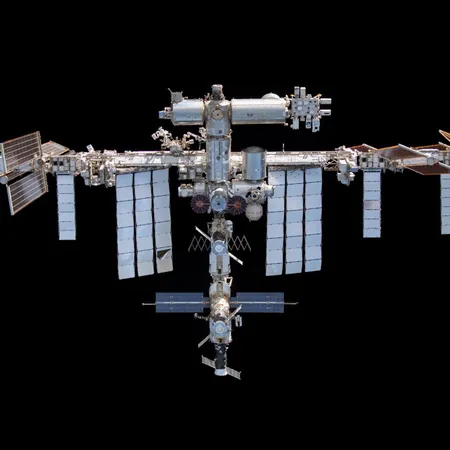
Ocean Experts Sound the Alarm Over International Space Station's Deorbit Plans!
2024-10-09
Author: Nur
NASA's Challenge with the ISS deorbiting
NASA faces a monumental challenge as it prepares to deorbit the International Space Station (ISS), a colossal structure weighing over 400 tons, by early 2031. The current plan is to guide this massive space station back to Earth and drop it into a remote area of the Pacific Ocean, a notion that has raised alarm bells among scientists, environmental watchdogs, and ocean conservationists.
Condition of the ISS
The ISS has suffered from decades of wear and tear, with reports highlighting issues such as cracks and air leaks. In light of its deteriorating condition, NASA has evaluated various decommissioning strategies, including bringing the station back to Earth piece by piece, relocating it to a higher orbit, or allowing it to decay naturally in space. Ultimately, NASA determined that using a U.S.-developed Deorbit Vehicle (USDV) to facilitate a controlled descent into the ocean is the most viable option.
USDV Collaboration with SpaceX
In a recent announcement, NASA revealed its collaboration with SpaceX to design this USDV, backed by a contract worth up to $843 million. The vehicle will be based on an upgraded version of the Dragon spacecraft, equipped with enhanced thrusters and a revamped trunk that can carry significantly more propellant—six times more than the typical Dragon. The intention is for the vehicle to execute a controlled, destructive re-entry, with hopes most ISS components will incinerate upon entering the atmosphere. However, some denser materials could survive, posing a potential threat to marine ecosystems.
Impact Location: Point Nemo
The chosen impact location for the ISS's final descent is Point Nemo, also referred to as "the pole of inaccessibility." This remote area is already utilized as a trash repository for decommissioned space equipment due to its distance from land, which further complicates the discussions surrounding the environmental implications of such an action.
Concerns from Environmental Experts
Environmental experts are echoing concerns, with Edmund Maser, a molecular biologist, critiquing the plan as "questionable." He warns that ocean dumping has previously led to unforeseen consequences, citing the careless disposal of WWII munitions that have since corroded, leaching toxic materials into marine environments. Maser fears that future generations will suffer the consequences of today's decisions regarding the ISS's disposal.
EPA's Involvement
In addition, the U.S. Environmental Protection Agency (EPA) is currently assessing the regulatory framework needed for managing the ISS's disposal, though details remain undisclosed. The sheer scale of the ISS's re-entry—set to be the largest in history—adds to uncertainty, as environmental scientists, like Ph.D. candidate Ewan Wright, express concerns about the unknown materials onboard that may become hazardous to marine life post-re-entry.
Critics' Perspectives
George Leonard, chief scientist for the Ocean Conservancy, articulated that merely relocating the ISS to the ocean is akin to treating it as a dumping ground, much like the single-use plastics polluting our waters. He stressed that this pattern of neglecting the end-of-life phases of our creations—be they spacecraft or everyday products—reveals a troubling trend in humanity’s relationship with waste.
Broader Environmental Responsibilities
The conversation around the ISS disposal isn't just about clearing outer space; it's a reflection of our broader environmental responsibilities. Critics urge us to rethink our approach, emphasizing that the effects of ocean dumping will inevitably ripple through our ecosystems and may lead to dire repercussions for ocean health.
Conclusion
In summary, as the clock ticks toward the ISS's deorbiting, the outcry for accountability and foresight grows louder. The stakes are high, and the decisions made today could have lasting impacts on our oceans and the planet's future. Stay tuned as we continue to cover this evolving story!



 Brasil (PT)
Brasil (PT)
 Canada (EN)
Canada (EN)
 Chile (ES)
Chile (ES)
 España (ES)
España (ES)
 France (FR)
France (FR)
 Hong Kong (EN)
Hong Kong (EN)
 Italia (IT)
Italia (IT)
 日本 (JA)
日本 (JA)
 Magyarország (HU)
Magyarország (HU)
 Norge (NO)
Norge (NO)
 Polska (PL)
Polska (PL)
 Schweiz (DE)
Schweiz (DE)
 Singapore (EN)
Singapore (EN)
 Sverige (SV)
Sverige (SV)
 Suomi (FI)
Suomi (FI)
 Türkiye (TR)
Türkiye (TR)